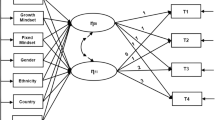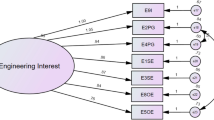Abstract
Students’ declining performance in science and mathematics is an issue of great international concern. Recently, educators and researchers have begun to focus on affective factors such as interest to better understand STEM learning and persistence. Therefore, there is a need for effective measures of STEM interest that allow it to be tracked over time and to provide opportunities for early interventions by educators. One such instrument was recently developed to measure youth interest in STEM as a general construct and in four domains associated with STEM: earth and space science, life science, technology and engineering, and mathematics. In this paper, we explore the psychometric properties of the measure scales by administering the instrument to a large sample of youth from both a traditional and STEM-focused school and examining theorized relationships using confirmatory factor analysis as part of a larger structural equation model. Results provided support for a single latent dimension of STEM interest, confirmed the existence of the four individual STEM interest dimensions, and provided evidence of structural and generalizability validity. We conclude that the instrument provides a sufficient means to measure STEM interest for adolescent youth within a variety of populations and educational contexts.

Similar content being viewed by others
References
Ahmed, W., van der Werf, G., Kuyper, H., & Minnaert, A. (2013). Emotions, self-regulated learning, and achievement in mathematics: A growth curve analysis. Journal of Educational Psychology, 105(1), 150–161.
Australian Curriculum, Assessment and Reporting Authority. (2015). The Australian Curriculum, Version 7.3, January 5, 2015. Sydney, NSW: ACARA.
Beavers, A. S., Lounsbury, J. W., Richards, J. K., Huck, S. W., Skolits, G. J., & Esquivel, S. L. (2013). Practical considerations for using exploratory factor analysis in educational research. Practical Assessment, Research & Evaluation, 18(6), 1–13.
Becker, K., & Park, K. (2011). Effects of integrative approaches among science, technology, engineering, and mathematics (STEM) subjects on students’ learning: A preliminary meta-analysis. Journal of STEM Education, 12, 23–37.
Buck Institute. (n.d.). What is project-based learning (PBL)? Retrieved 24 October 2018, from http://www.bie.org/about/what_pbl.
Burke, L., Francis, K., & Shanahan, M. (2014, July). A horizon of possibilities: A definition of STEM education. Paper presented at the STEM 2014 Conference, Vancouver, Canada.
Cattell, R. B. (1956). Personality and motivation theory based on structural measurement. In J. L. McCary (Ed.), Psychology of personality (pp. 51–98). New York, NY: Logos.
DeWitt, J., Osborne, J., Archer, L., Dillon, J., Willis, B., & Wong, B. (2011). Young children’s aspiration in science: The unequivocal, the uncertain and the unthinkable. International Journal of Science Education, 35(6), 1037–1063.
Dimitrov, D. (2012) Statistical methods for validation of assessment scale data in counseling and related fields. Alexandria, VA: American Counseling Association.
Elliot, B., Oly, K., McArthur, J., & Clark, B. (2001). The effect of an interdisciplinary algebra/science course on students’ problem solving skills, critical thinking skills and attitudes towards mathematics. International Journal of Mathematical Education in Science and Technology, 32(6), 811–816.
English, L. D. (2016). STEM education K-12: Perspectives on integration. International Journal of STEM Education, 3(1). https://doi.org/10.1186/s40594-016-0036-1.
Falk, J. H., Staus, N. L., Dierking, L. D., Penuel, W., Wyld, J., & Bailey, D. (2016). Understanding youth STEM interest pathways within a single community: the Synergies project. International Journal of Science Education, Part B, 6(4), 369-384.
Everett, L. J., Imbrie, P. K., & Morgan, J. (2000). Integrated curricula: Purpose and design. Journal of Engineering Education, 89(2), 167–175.
Fitzallen, N. (2015). STEM education: What does mathematics have to offer? In M. Marshman (Eds.), Mathematics education in the margins. Proceedings of the 38th annual conference of the Mathematics Education Research Group of Australasia (pp. 237–244). Sydney, Australia: MERGA.
Fornell, C., & Larcker, D. F. (1981). Evaluating structural equation models with unobservable variables and measurement error. Journal of Marketing Research, 18, 39–50.
Fortus, D. (2014). Attending to affect. Journal of Research in Science Teaching, 51(7), 821–835.
Harkness, W. (1965). Properties of extended hypergeometric distributions. The Annals of Mathematical Statistics, 36(3), 938–945.
Häussler, P., & Hoffmann, L. (2002). An intervention study to enhance girls’ interest, self- concept, and achievement in physics classes. Journal of Research in Science Teaching, 39(9), 870–888.
Hidi, S., & Renninger, K. A. (2006). The four-phase model of interest development. Educational Psychologist, 41(2), 111–127.
Hu, L., & Bentler, P. M. (1999). Cutoff criteria for fit indexes in covariance structure analysis: Conventional criteria versus new alternatives. Structural Equation Modeling, 6, 1–55.
Judson, E., & Sawada, D. (2000). Examining the effects of a reformed junior high school science class on students’ math achievement. School Science and Mathematics, 100(8), 419–425.
Krapp, A. (2002). An educational-psychological theory of interest and its relation to self- determination theory. In E. Deci & R. Ryan (Eds.), The handbook of self-determination research (pp. 405–427). Rochester, NY: University of Rochester Press.
Krapp, A., & Prenzel, M. (2011). Research on interest in science: Theories, methods, and findings. International Journal of Science Education, 33(1), 27–50.
Lamb, R., Akmal, T., & Petrie, K. (2015). Development of a cognition-priming model describing learning in a STEM classroom. Journal of Research in Science Teaching, 52(3), 410-437.
Lesseig, K., Firestone, J., Morrison, J., Slavit, D., & Nelson, T. (2019). An analysis of cultural influences on STEM schools: Similarities and differences across K-12 contexts. International Journal of Science and Mathematics Education. 17(3), 449-466.
Maltese, A. V., & Tai, R. H. (2011). Pipeline persistence: Examining the association of educational experiences with earned degrees in STEM among U.S. students. Science Education, 95(5), 877–907.
Maltese, A. V., Melki, C. S., & Wiebke, H. L. (2014). The nature of experiences responsible for the generation and maintenance of interest in STEM. Science Education, 98, 937–962.
Marsh, H. W., Morin, A. J., Parker, P. D., & Kaur, G. (2014). Exploratory structural equation modeling: An integration of the best features of exploratory and confirmatory factor analysis. Annual Review of Clinical Psychology, 10, 85–110.
Messick, S. (1989). Validity. In R. L. Linn (Ed.), Educational measurement (3rd ed., pp. 13–103). New York, NY: Macmillan.
Minner, D., Erickson, E., Wu, S., & Martinez, A. (2012). Compendium of research instruments for STEM education. Part 2: Measuring students’ content knowledge, reasoning skills, and psychological attributes. Cambridge, MA: ABT Associates. Retrieved on July 27, 2014 from http://cadrek12.org/announcements/findingsdr-k-12-stem-school-study-s3-project Retrieved July 27, 2014.
Moore, T. J., & Smith, K. A. (2014). Advancing the state of the art of STEM integration. Journal of STEM Education, 15(1), 5–10.
Morrison, J. (2006). Attributes of STEM education: The students, the academy, the classroom. Baltimore, MD: Teaching Institute for Excellence in STEM.
National Research Council. (2011). Successful K-12 STEM education: Identifying effective approaches in science, technology, engineering, and mathematics. Washington, DC: National Academies Press.
National Research Council. (2012). A framework for K-12 science education: Practices, crosscutting concepts, and core ideas. Washington, DC: National Academies Press.
National Research Council. (2013). Next generation science standards: For states, by states. Washington, DC: National Academies Press.
National Science Board. (2010). Science and engineering indicators 2010. Arlington, VA: National Science Foundation.
Office of the Chief Scientist. (2013). Science, technology, engineering and mathematics in the national interest: A strategic approach. Canberra, Australia: Australian Government. Canberra: Australian Government.
President’s Council of Advisors on Science and Technology. (2010). Prepare and inspire: K-12 education in science, technology, engineering and math (STEM) for America's future. Washington, DC: Executive Office of the President.
Raykov, T. (1998). Coefficient alpha and composite reliability with interrelated nonhomogeneous items. Applied Psychological Measurement, 22(4), 375–385.
Renninger, K. A., & Hidi, S. (2011). Revisiting the conceptualization, measurement, and generation of interest. Educational Psychologist, 46(3), 168–184.
Renninger, K. A., & Su, S. (2012). Interest and its development. In R. Ryan (Ed.), The Oxford handbook of human motivation (pp. 167–187). New York, NY: Oxford University Press.
Ruo, B., Baker, D. W., Thompson, J. A., Murray, P. K., Huber, G. M., & Sudano, J. J., Jr. (2008). Patients with worse mental health report more physical limitations after adjustment for physical performance. Psychosomatic Medicine, 70(4), 417–421.
Sadler, P. M., Sonnert, G., Hazari, Z., & Tai, R. (2012). Stability and volatility of STEM career interest in high school: A gender study. Science Education, 96(3), 411–427.
Sanders, M. (2009). STEM, STEM education, STEM mania. Technology Teacher, 68(4), 20–26.
Schreiner, C., & Sjøberg, S. (2004). Sowing the seeds of ROSE. Background, rationale, questionnaire development and data collection for ROSE (The Relevance of Science Education) – A comparative study of students’ views of science and science education (pdf) (Acta Didactica 4/2004). Oslo, Norway: Department of Teacher Education and School Development, University of Oslo.
Sjøberg, S., & Schreiner, C. (2010). The ROSE project. An overview and key findings. Retrieved from. http://roseproject.no/network/countries/norway/eng/nor-Sjoberg-Schreiner-overview-2010.pdf.
Tai, R. H., Liu, C. Q., Maltese, A. V., & Fan, X. (2006). Planning early for careers in science. Science, 312, 1143–1144.
The Royal Society Science Policy Centre. (2014). Vision for science and mathematics education. London, England: The Royal Society.
UK Department for Education (2015). National curriculum in England: Science programmes of study. Retrieved from https://www.gov.uk/government/publications/national-curriculum-in-england-science-programmes-of-study.
Vedder-Weiss, D., & Fortus, D. (2011). Adolescents’ declining motivation to learn science: Inevitable or not? Journal of Research in Science Teaching, 48(2), 199–216.
Author information
Authors and Affiliations
Corresponding author
Rights and permissions
About this article
Cite this article
Staus, N.L., Lesseig, K., Lamb, R. et al. Validation of a Measure of STEM Interest for Adolescents. Int J of Sci and Math Educ 18, 279–293 (2020). https://doi.org/10.1007/s10763-019-09970-7
Received:
Accepted:
Published:
Issue Date:
DOI: https://doi.org/10.1007/s10763-019-09970-7




